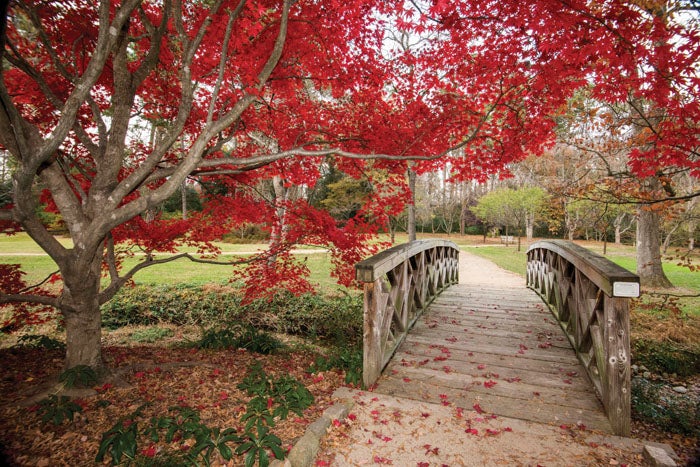Danelle Cutting column: Fall colors — not just for the mountains
Published 12:00 am Sunday, October 4, 2020

- JON C. LAKEY / SALISBURY POST The Japanese Maple tree at Hurley Park at the foot bridge near Annandale Avenue turns blood red in the fall.
The recent weather changes have me longing for apple cider, cozy socks, and fall colors. I know when I think of fall colors, I am usually picturing a drive on the Blue Ridge Parkway. However, there’s plenty of opportunity to see great fall color in our own backyard, if we take the time to look. There are even a few plants changing colors right now in Hurley Park.
The first plant that comes to mind is the native Oakleaf Hydrangea (Hydrangea quercifolia). It is currently exhibiting a change in color and can be viewed in Jane’s Garden and the Gascoigne Fern Glade. The large leaves are a range of colors from purple to burgundy to deep orange. In Priscilla’s Fragrance Garden, the Virginia Sweetspire (Itea virginica ‘Henry’s Garnet’) is already showing a dark red hue on its leaves which will hang on until the beginning of winter. The Flowering dogwoods (Cornus florida) near our main entrance have transitioned into their warm fall colors and will hold onto their leaves into late fall, too. Many commonly planted maple species are just starting to turn shades of red and orange, but I am anxiously waiting for Hurley Park’s Japanese Maples (Acer palmatum var. atropurpureum ‘Bloodgood’) to turn a brilliant shade of red. Other plants to look for striking fall color from in Hurley Park are the Sweet Pepperbush (Clethra alnifolia), Witch Hazel (Hamamelis spp.), and Black Gum (Nyssa sylvatica).
So why do these color changes occur and how do the trees know when to do this? Plants make their food via photosynthesis and they do this with a pigment called chlorophyll. However, as the days get shorter and cooler, trees stop producing these chlorophyll pigments and start shutting down the photosynthesis process to prepare for the winter. This allows for other molecules called carotenoids and anthocyanins to “shine” through. The carotenoids are present all year in the leaves and help to absorb additional wavelengths of light that chlorophyll is not able to and provides protection from sunburn by diverting excess energy from chlorophyll molecules. The carotenoids are responsible for the yellow and orange coloration of leaves. The anthocyanins are produced right before leaves fall to provide protection from excess sunlight and aid in recovery of nutrients. The anthocyanins give us the brilliant reds we will see in the Bloodgood Japanese Maple, but only if needed. If it is a rainy or cloudy fall, the red leaves won’t be as prevalent like during a dry, sunny fall season.
When can we expect peak fall color at Hurley Park? According to the Smoky Mountains’ 2020 prediction and the N.C. State College of Natural Resources News, the peak leaf season in the Piedmont of North Carolina will be mid-October. Until then, I will be watching for the subtle changes and hoping for sunny, dry days to promote bright fall colors! See you in the park.
If you have questions about the park or what is in bloom, please give us a call at 704-638-5298 or contact us on Facebook or Instagram @HurleyParkNC. If you would like to donate to Hurley Park, go to salisburync.gov/hurleypark.
Danelle Cutting is the manager of Hurley Park.



